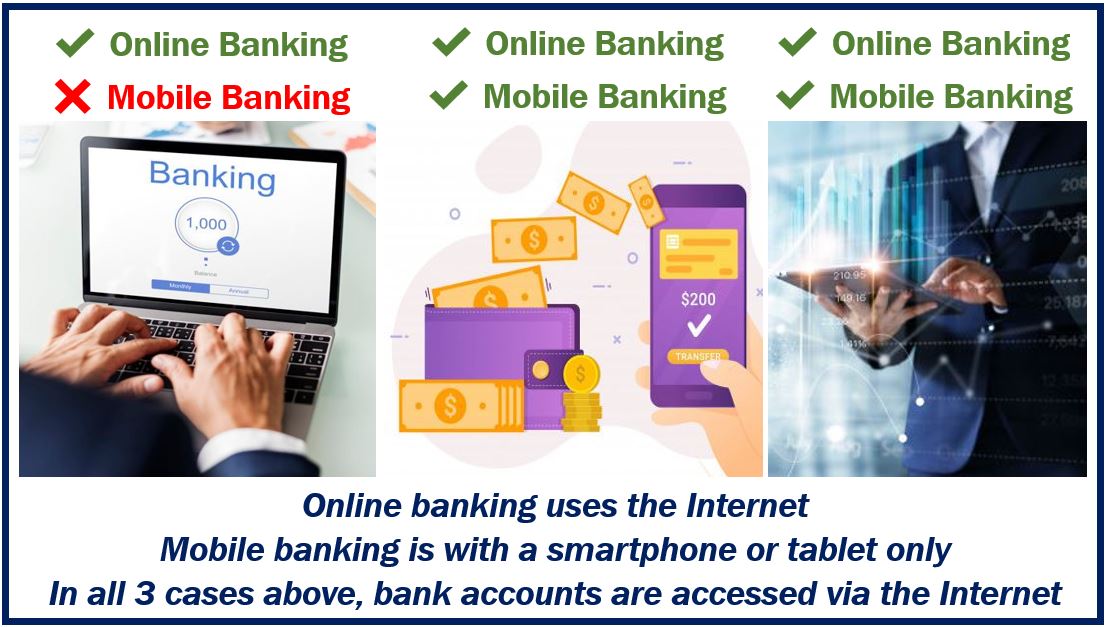Not so long ago, you would have to go to the bank to make payments and check your bank account status, among other things. Today it’s enough to have an internet connection, and you can do all those things and more from the comfort of your home. Chances are high, though, that you use online banking and mobile banking terms interchangeably. They don’t have the same meaning. To help you get the most out of your online banking or mobile banking experience, we’re going to elaborate on their differences.

Mobile banking vs. online banking
The term mobile banking refers to the use of a smartphone or tablet instead of a desktop computer to conduct financial transactions, check the balance, and use other services.
On the flip side, online banking is any banking transaction that you can carry out on the internet. This is generally done on the bank’s official website under a private account via desktop or laptop computer.
Although not the same thing, online and mobile banking allow you to access your account and use various services without having to go to the bank.
Functionality is yet another point of difference between online and mobile banking. To use online banking, you need an internet connection. Mobile banking doesn’t always require an internet connection, as many banks allow clients to use certain services through text messaging.
Advantages of mobile banking
Ask anyone, and they’ll tell you how much they dislike going to the bank to take care of some basic things such as sending money to someone. Going to the bank isn’t the issue here, but the fact it takes time to get there, then you have to stand in line and wait for your turn.
Busy schedule and hectic lifestyle don’t always allow that to happen. And in the time of COVID-19 pandemic, the last thing you want is to wait in line. That’s why more and more people finally understand the advantages of mobile banking.
Here are some of the greatest benefits of mobile banking you should know:
- Easy to use
- Accessibility i.e., ability to access your account on a mobile device whenever you want/need
- Saves time
- Convenient
- Cost-effective
- Higher security
Is banking on mobile safe?
One of the greatest advantages of mobile banking is of higher security. Banks are supposed to guard your assets, and these include your interactions on mobile apps.
You see, the bank provides you with a set of credentials necessary to log into the account and make transactions. This information is securely given to you. The only person who knows your username and password is you. That way, the account is safe.
To protect their clients from hackers and other potential problems, banks work on developing new security measures. These methods work to take the safety of your account to a whole new level. For instance, most banks today allow clients to activate two-step verification.
Once you activate two-step verification, you can make transactions only when you enter a one-time password (OTP) sent to the phone number associated with your account.
What are the security risks of mobile banking?
Even though mobile baking is safe and secure, you need to keep in mind nothing is foolproof. Security risks of mobile banking include:
- Mobile malware (viruses, Trojans, malvertizing, rootkits, and spyware)
- Poor app design, configuration, and corrupt apps
- Poor security of WiFi networks
- Mobile devices ID vulnerabilities
Banks work hard to protect the information and privacy of their clients. But, a lot of security risks are down to mistakes that people make while using their smartphones and tablets.
How can I protect my mobile banking?
Sometimes we make mistakes without even realizing it, and, unfortunately, they can affect the security of mobile banking. Fortunately, there is a lot you can do to protect your mobile banking experience and ensure you’re safe and secure at all times.
Before downloading the bank app, always make sure you’re dealing with the real thing, not the fake app. You can do by reading reviews or simply head to the bank website, find the app section, and get access to the download from there.
When you’re not home, avoid using public WiFi to carry out mobile banking business. Instead, use cellular data or wait until you get home.
To protect mobile banking and ensure safety, you also need to update the bank app regularly. The latest updates can come with security upgrades, which you would miss if you choose to ignore them.
While it seems easy and convenient to store passwords and PIN on your phone, make sure to avoid doing so.
Instead of choosing some obvious and easy password, you should make sure it’s tricky. Speaking of passwords, it’s practical to password-protect your phone as well.
When receiving emails, you should avoid opening any link that seems suspicious. You need to stay away from suspicious websites known for infecting a device with viruses.
Conclusion
Mobile banking has a wide range of advantages. Thanks to a smartphone or tablet, we can send money, pay bills, or check balance wherever we are. While mobile banking is safe, some security risks still exist. The security risks are closely linked to our habits i.e., things we do when using our devices. It’s crucial to avoid public WiFi, weak passwords, and ignoring updates. To get the most out of mobile banking experience, you should contact the bank for all questions you have and seek advice.
Interesting related article: “What is Online Banking?”

